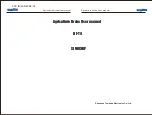
Pre-Flight Safety Check
Thoroughly check the craft before every flight…
Open the body and check to see if all the components are safe and secure and not loose.
Check to see if any wires have come off
Check for loose bolts on the assembly
Check that the battery’s are secure
Check the battery voltage, and if you have more than one battery, check your spares too
Check the propellers for marks and nicks
Check the propeller nuts or bolts, make sure they are tight
Check the engine mounts and the bolts and nuts for tightness
Check the Transmitter battery voltage; never fly the craft with a low voltage reading on your transmitter (check with the manufacturer of your equipment
for minimum and maximum voltage readings).
Check that the transmitter antenna is not damaged.
Check that the craft receiver module is well connected and that the antenna’s are properly positioned.
Take a good look over the craft from all sides to make sure that nothing appears unusual or out of place.
Check your flight perimeter
Check for power-lines and overhead obstacles.
Assess the weather conditions, wind direction and speed. An anemometer (hand held wind speed meter) is a good tool to have otherwise use some dry
grass or a tissue, throwing in the air to gauge the wind direction. Do not fly in gusty and turbulent conditions.
Set your transmitter timer to 80% of the known battery duration.
6
Summary of Contents for SkyJib 6
Page 1: ......
Page 3: ...F L I G H T O P S A N D S A F E T Y ...
Page 8: ...P R E B U I L D C H E C K L I S T S ...
Page 9: ...Required Tools M4 3mm Hex Screw Driver M4 7mm Hex Driver 3mm Phillips Head Driver ...
Page 12: ...A S S E M B L Y I N S T R U C T I O N S ...
Page 38: ...4 Place a cage hub on top of the arches ensuring the notches slot into the hub grooves 38 ...
Page 44: ...6 Completed crash cage ...
Page 48: ...T I P S T R I C K S A N D R E C O M M E N D A T I O N S ...





























